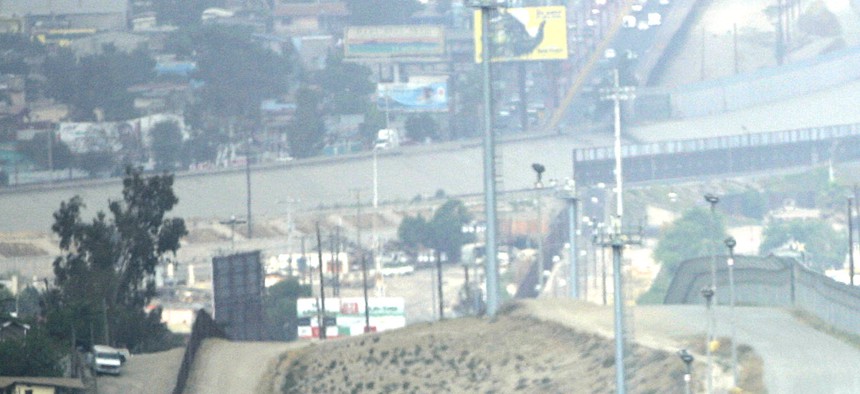DHS Wants Facial Recognition Border Surveillance System

A lone Border Patrol vehicle along with tower mounted video cameras monitor activity along the border fence between Tijuana and San Diego. Lenny Ignelzi/AP file photo
The department is exploring technology that would use various biometric matching techniques to track the exit of foreign visitors.
The Homeland Security Department is exploring technology that would use facial and iris recognition to track the departure of foreign visitors, according to contracting documents.
“At land border exit[s], currently there are no biometrics captured resulting in an inability to accurately verify that a departing traveler matches a specific entry record," states a market research survey released on Wednesday. "To biometrically identify the broadest set of travelers as well as to discourage spoofing attempts, it is envisioned that the exit solution may utilize more than one biometrics modality."
The system officials have in mind would be deployed at crossings for pedestrians and drivers.
DHS has struggled for years to keep tabs on travelers who overstay their visas, such as Amine El Khalifi, a Moroccan immigrant living in Virginia on an expired 1999 visa, when, in 2012, he attempted to bomb the U.S. Capitol Building.
More than a decade ago, DHS began trying out machinery to check the fingerprints and photos of visitors entering and exiting the United States. But the exit component of the system -- the one that would spot invalid visas -- still does not exist.
The bar for precision in Homeland Security’s latest effort is set high:
Officials say their goal is a system that can biometrically identify more than 97 percent of foreign pedestrians. The plans expect that services will be available for “fingerprint, iris, and facial matching capabilities and solutions."
The survey asks contractors, “What are your views on the key tradeoffs between leveraging the existing fingerprint enrollment database for exit identity verification versus creating a solution with iris or face or both? How are these tradeoffs affected by the pedestrian versus vehicular environments?”
Visitors’ names and other descriptive information are too easy to intentionally or inadvertently record incorrectly, say proponents of using biometric identification to track exits.
"Recently it was discovered that Boston Marathon bomber Tamerlan Tsarnaev’s name was misspelled on a manifest list of a flight to Russia, meaning that the FBI did not have the benefit of an important lead in investigating his terrorist ties," Janice Kephart, a former special counsel for the Senate Judiciary Committee, testified to House lawmakers in November 2013. Even software that could detect such name anomalies would fail to flag “complete biographic identity changes, a much more nefarious problem that biometrics solves in seconds."
Comprehensive immigration reforms approved in the Senate last year would require a computerized biometric exit system that, according to the Los Angeles Times, could cost more than $7 billion.
This week's request for information from industry asks for "a realistic timeline, projected cost and feasibility of achieving the goal" of accurate identification.
NEXT STORY: Social Media Makes the State Department Nimbler






